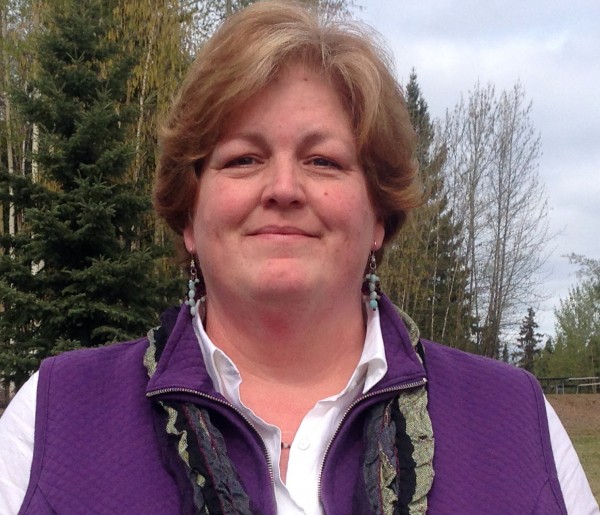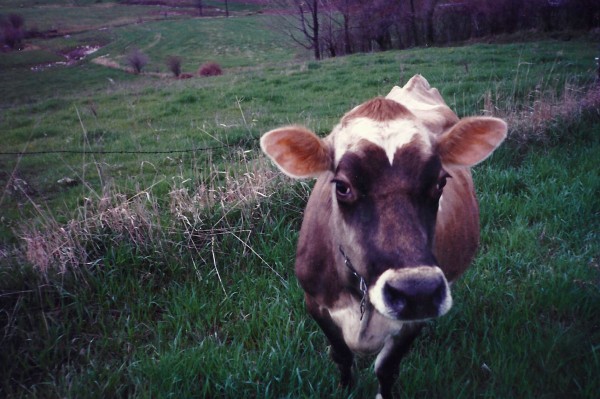Lunn brings diverse veterinary background to –‘”˚…Á
February 10, 2016
Meghan Murphy
474-7541
Don’t underestimate a cow.
Especially one that’s been hand-raised and is accustomed to people, said Dr. Lisa
Lunn, who is an associate professor of veterinary medicine at the University of Alaska
Fairbanks. She said her husband wasn’t a believer in cow smarts until he met her cow,
Evelyn, on her parents’ dairy farm.
He saw Evelyn respond to her name. She took walks like a dog. And the first time she
saw the couple — then engaged — about to hold hands on a country trek, she squeezed
between them and body checked the fiancé, sending him flying into a ditch.
Under Lunn’s gentle direction, he grabbed a handful of alfalfa and tremulously offered
it to the Evelyn. She ate it. All was good.

While the story always gets a laugh, Lunn tells it to illustrate that farm animals like cows, horses, goats, sheep and pigs are all smart in their own way, and it’s important to know how they perceive the world if you want to treat them as a veterinarian.
These pearls of wisdom add levity to her intense technical classes, which cover things like prolapsed uteruses, diseases and the internal workings of large animals. The classes are part of the joint professional veterinary medicine program between –‘”˚…Á‚Äôs Department of Veterinary Medicine and Colorado State University.
But that‚Äôs only half her job. The other half is being the only large animal extension veterinarian for the state of Alaska through –‘”˚…Á‚Äôs School of Natural Resources and Extension. In this role, she provides information and resources to large-animal farm owners throughout Alaska and researches science that is relevant to them.
When Lunn came to –‘”˚…Á more than a year ago, she traveled throughout Alaska to get the feel and vibe for large-animal farming and ranching in the state.
“I found that we have a lot of small farmers that are very new to the game,” she said. "They may not have grown up on a farm or have had previous experience. They’re doing a great job, but they need resources. They need help and information.”
She added that large animal veterinarians are few in Alaska, a state whose size and remoteness can make it challenging for some farms to take advantage of services.

To help, Lunn is developing an online course about animal husbandry and health. She is also working with a research team to collect baseline data on the types of pests found in large animals throughout Alaska, an area of knowledge that is lacking. The results of the research will help large-animal owners make better-informed decisions in managing parasites and other pests in their animals.
Lunn said she welcomes working in such a large state, given that her previous job was on the tiny island country of Grenada, which is about 20 miles long and 12 miles wide — a dot on a map of the Caribbean. For five years she taught large-animal medicine at Grenada’s St. George’s University School of Veterinary Medicine and helped the school earn accreditation with the American Veterinary Medical Association.
“The agriculture on this little island was a complete 180 from what I was used to,” she said. “Farming is very free range. People will tie their goats and sheep along the road. When they came home from work, the people would untie the sheep and goats, which would run and beat their owners home.”
While the contrast between Grenada and Alaska seems great, she said the contrast between Grenada and Michigan — the place where she previously taught veterinary medicine — is also stark. Michigan has more than 1 million cattle, and some farms have as many as 10,000.
Lunn taught veterinary medicine at Michigan State University after earning her doctorate in veterinary medicine from Kansas State University in 1999. She said her experience with large, small and remote farms will only help her in Alaska.
“Michigan had a lot of bigger, well-established farms that were very profit-oriented. Grenada was really taking it back to the basics. Alaska has a mix of everything. You have people who are just getting into farming. You have some bigger, well-established herds. So Alaska has been the perfect mix of every previous job I’ve had,” she said.
Lunn’s new job has also included some unexpected roles. She’s helping coordinate a visit later this month by well-known autism advocate and animal researcher Temple Grandin.
Grandin is a professor of animal science from Colorado State University who is famous for designing facilities and handling procedures that have improved the welfare of farm animals worldwide. She attributes much of her success to the way her autism allows her to see small details that make a big difference.
Lunn first saw Grandin speak in the early 1990s when she came to Lunn‚Äôs veterinary class to talk about reforming facilities for cattle. Two decades later, she‚Äôll talk to the first class of veterinary students at –‘”˚…Á.
Lunn said Grandin is a great role model for the students to draw inspiration from, as she herself did. Lunn wanted to be a large animal veterinarian but was concerned that she hadn’t met many women — veterinarians or researchers — working in the cattle industry.
“That’s the thing that amazes me about Temple Grandin — not just her contribution to the livestock industry and improving the welfare and the standards but she did it as a woman in an industry that wasn’t always receptive to that,” Lunn said. “She didn’t let that stand in her way and she let her work speak for itself.”


